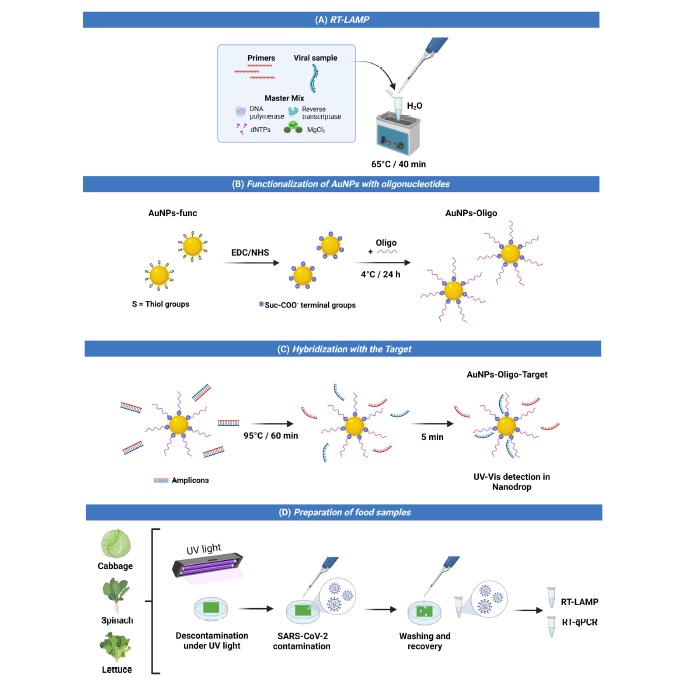Development and application of an SPR nanobiosensor based on AuNPs for the detection of SARS-CoV-2 on food surfaces.
TESSARO, Larissa; AQUINO, Adriano; PANZENHAGEN, Pedro; OCHIONI, Alan Clavelland; MUTZ, Yhan S.; RAYMUNDO-PEREIRA, Paulo Augusto; VIEIRA, Italo Rennan Sousa; BELEM, Natasha Kilsy Rocha; CONTE-JUNIOR, Carlos Adam.
TESSARO, Larissa; AQUINO, Adriano; PANZENHAGEN, Pedro; OCHIONI, Alan Clavelland; MUTZ, Yhan S.; RAYMUNDO-PEREIRA, Paulo Augusto; VIEIRA, Italo Rennan Sousa; BELEM, Natasha Kilsy Rocha; CONTE-JUNIOR, Carlos Adam.




 Abstract: A new transmission route of SARS-CoV-2 through food was recently considered by the World Health Organization (WHO), and, given the pandemic scenario, the search for fast, sensitive, and low-cost methods is necessary. Biosensors have become a viable alternative for large-scale testing because they overcome the limitations of standard techniques. Herein, we investigated the ability of gold spherical nanoparticles (AuNPs) functionalized with oligonucleotides to detect SARS-CoV-2 and demonstrated their potential to be used as plasmonic nanobiosensors. The loop-mediated isothermal amplification (LAMP) technique was used to amplify the viral genetic material from the raw virus-containing solution without any preparation. The detection of virus presence or absence was performed by ultraviolet-visible (UV-Vis) absorption spectroscopy, by monitoring the absorption band of the surface plasmonic resonance (SPR) of the AuNPs. The displacement of the peak by 525 nm from the functionalized AuNPs indicated the absence of the virus (particular region of gold). On the other hand, the region ~300 nm indicated the presence of the virus when RNA bound to the functionalized AuNPs. The nanobiosensor system was designed to detect a region of the N gene in a dynamic concentration range from 0.1 to 50 × 10 3 ng·mL-1 with a limit of detection (LOD) of 1 ng·mL-1 (2.7 × 10 3 copy per µL), indicating excellent sensitivity. The nanobiosensor was applied to detect the SARS-CoV-2 virus on the surfaces of vegetables and showed 100% accuracy compared to the standard quantitative reverse transcription polymerase chain reaction (RT-qPCR) technique. Therefore, the nanobiosensor is sensitive, selective, and simple, providing a viable alternative for the rapid detection of SARS-CoV-2 in ready-to-eat vegetables.
Abstract: A new transmission route of SARS-CoV-2 through food was recently considered by the World Health Organization (WHO), and, given the pandemic scenario, the search for fast, sensitive, and low-cost methods is necessary. Biosensors have become a viable alternative for large-scale testing because they overcome the limitations of standard techniques. Herein, we investigated the ability of gold spherical nanoparticles (AuNPs) functionalized with oligonucleotides to detect SARS-CoV-2 and demonstrated their potential to be used as plasmonic nanobiosensors. The loop-mediated isothermal amplification (LAMP) technique was used to amplify the viral genetic material from the raw virus-containing solution without any preparation. The detection of virus presence or absence was performed by ultraviolet-visible (UV-Vis) absorption spectroscopy, by monitoring the absorption band of the surface plasmonic resonance (SPR) of the AuNPs. The displacement of the peak by 525 nm from the functionalized AuNPs indicated the absence of the virus (particular region of gold). On the other hand, the region ~300 nm indicated the presence of the virus when RNA bound to the functionalized AuNPs. The nanobiosensor system was designed to detect a region of the N gene in a dynamic concentration range from 0.1 to 50 × 10 3 ng·mL-1 with a limit of detection (LOD) of 1 ng·mL-1 (2.7 × 10 3 copy per µL), indicating excellent sensitivity. The nanobiosensor was applied to detect the SARS-CoV-2 virus on the surfaces of vegetables and showed 100% accuracy compared to the standard quantitative reverse transcription polymerase chain reaction (RT-qPCR) technique. Therefore, the nanobiosensor is sensitive, selective, and simple, providing a viable alternative for the rapid detection of SARS-CoV-2 in ready-to-eat vegetables. @article={003110037,author = {TESSARO, Larissa; AQUINO, Adriano; PANZENHAGEN, Pedro; OCHIONI, Alan Clavelland; MUTZ, Yhan S.; RAYMUNDO-PEREIRA, Paulo Augusto; VIEIRA, Italo Rennan Sousa; BELEM, Natasha Kilsy Rocha; CONTE-JUNIOR, Carlos Adam.},title={Development and application of an SPR nanobiosensor based on AuNPs for the detection of SARS-CoV-2 on food surfaces},journal={Biosensors},note={v. 12, n. 12, p. 1101-1-1101-14},year={2022}}
@article={003110037,author = {TESSARO, Larissa; AQUINO, Adriano; PANZENHAGEN, Pedro; OCHIONI, Alan Clavelland; MUTZ, Yhan S.; RAYMUNDO-PEREIRA, Paulo Augusto; VIEIRA, Italo Rennan Sousa; BELEM, Natasha Kilsy Rocha; CONTE-JUNIOR, Carlos Adam.},title={Development and application of an SPR nanobiosensor based on AuNPs for the detection of SARS-CoV-2 on food surfaces},journal={Biosensors},note={v. 12, n. 12, p. 1101-1-1101-14},year={2022}}